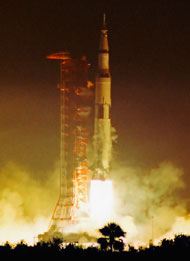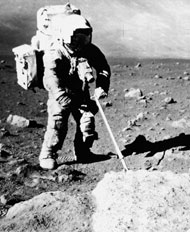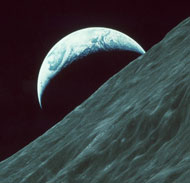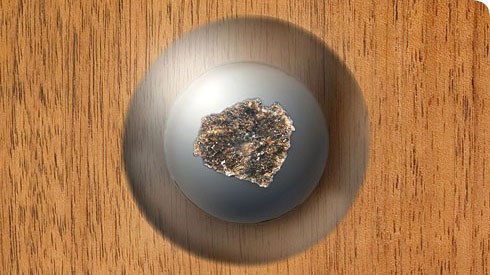Moon rock
There is just 1 piece of Moon rock in the UK from the last NASA Apollo mission and it is here in the Natural History Museum. It was a gift to the country from President Nixon in 1973. The fragment continues to provide insights into the Moon and its origins.

Apollo17 lift-off, 1972. © Ctein / Science Faction / Getty Images
Symbol of global unity and peace
Astronauts from the USA Apollo Moon missions are the only humans to leave Earth and land on another celestial body.
NASA owns the vast majority of Moon samples they collected. But as a goodwill gesture President Nixon gave fragments from the last manned mission, Apollo 17, to 135 other countries around the world.
The pieces of basalt were collected from the Taurus-Littrow Valley of the Moon. They were mounted on plaques with the recipient country’s flag, which the astronauts had taken into space with them. A message accompanying the UK fragment says it is given 'as a symbol of the unity of human endeavour and carries with it the hope of the American people for a world at peace'.
Space race
In 1957, Russia became the first nation to launch an object into space, Sputnik 1, and landed the first spacecraft, Luna 2, on the Moon in 1959.

Dr Harrison Schmitt on Apollo17 was the first and last professional geologist on the Moon. © NASA / Science Photo Library
Rockets capable of reaching the Moon could also launch bombs at the USA. So to reassert its technological prowess the USA created Apollo, and became the first nation to land humans on the Moon. The Apollo programme was the pinnacle of the space race.
Moon mission
The USA was determined to be the first to plant its flag on the Moon, and Buzz Aldrin and Neil Armstrong did so when Apollo 11 landed in 1969.
But Apollo also had scientific objectives: to study the Moon's composition, whether its core is hot or cold, how it was made and how the surface features were formed.
Apollo 17, in 1972, was the last chance to make non-robotic collections of data and specimens.
The astronauts measured small moonquakes, indicating an active molten interior. But since the oldest Moon rocks were millions of years older than Earth's, it seems that the Moon’s volcanoes stopped being active a long time ago.

Earth seen from the Moon during the Apollo17 mission. © Space Frontiers / Archive Photos / Getty Images
Clues to the Moon’s origins
We are still learning about the Moon's origins from Apollo rock specimens. Early results indicated that it broke away from Earth when a mass the size of Mars collided. But recently water was found locked in Moon rock that should have evaporated during impact. International studies involving our scientists have shed more light on the conundrum.
Similarities between Earth and Moon rocks suggest they were indeed once part of the same body or mixed thoroughly with each other before they formed. Heavy meteorite bombardment may have brought water and other materials essential for life into the Earth and Moon approximately 4-3.8 billion years ago, shortly before life evolved on Earth. This small piece of Moon rock still holds many answers.
Further information
- Visit the Moon rock in our new Treasures Cadogan Gallery.
- Find out more about the Moon, Earth's only natural satellite.
- Other fragments from space make their way to Earth without help from humans. Find out about meteorites and what they can tell us.
Vote for your favourite treasure
Is this your favourite Museum treasure? Let us know by voting in our poll.
Listen to the Treasures podcast
Moon rock story

Astronaut Harrison Schmitt and Museum planetary expert Sara Russell bring an earthly perspective to this extraterrestrial symbol of human endeavour.
